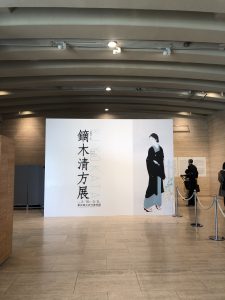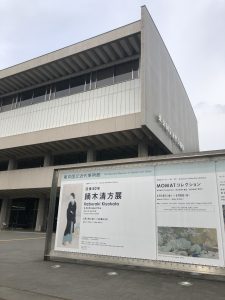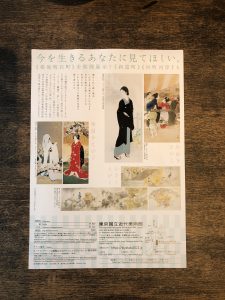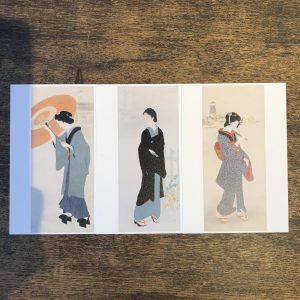鏑木清方展のパネルが大変美しい件~東京国立近代美術館(愛知県名古屋市千種区姫池通 骨董買取 古美術風光舎名古屋店)
2022.05.01
みなさまこんにちは、スタッフYでございます。
このところの時候の良さに風光舎スタッフもそれぞれ様々なところにお出かけしており、私も少しばかり浮足立っております。ゴールデンウィークの真っ最中、皆さまはいかがお過ごしでしょうか。
本日は連休の中休みと言ったところでしょうか、ここ名古屋は朝からしっとりと雨が降っておりまして少し肌寒いくらいでございます。体調など崩しませんようご自愛くださいませ。
ところで私も連休の少し前ですが、都内に少し足を伸ばしお休みを堪能してまいりました。今回の上京はここに照準を合わせたのですが、
「没後50年 鏑木清方展」

何を隠そうその昔、こちらの美術館の極近にてしばらくお勤めしておりました。にもかかわらず、当時の私はそんな気持ちの余裕もなく、あまり訪れたことが無かったことが今になって悔やまれる国立近代美術館にて開催されております。会期は3月18日~5月8日。連休は殺到するであろうと予測いたしまて少し前の訪問であります。

前置きはさておき「鏑木清方展」行ってまいりました。
いきなりですが、パネルが目の前に。その陶器のような女性の顔を佇まいの美しさにいきなり引き込まれます。こちらの作品は「築地明石町」という有名な作品でして、清方が49歳のときに描き、第8回帝国美術院展覧会(1927年)にて帝国美術院賞を受賞をいたしました。こちらの作品の話は後ほどすると致しまして。
東京神田に生まれた鏑木清方(かぶらききよかた 1878-1972)は、浮世絵系の水野年方(1866-1908)に入門して、挿絵画家として画業をスタートさせます。日本画では文展、帝展を主たる舞台として、美人画家として上村松園(1875-1949)と並び称されておりますが、私の印象ですと鏑木清方作品は「初雪」などの美人画もそうですが「雛市」や「鰯」のような幼い子供や庶民の日々の作品などもあり、どの作品にも穏やかなセリフをつけたくなるような日常の切り取りのような風景が描かれてた作品の印象であります。作品のすべてがそこで生活して生きていた人物の息遣いが感じられるといいましょうか。
有名な「鰯」などは、当時下町に生きた庶民の生活を細かく捉えてそれが面白くて、その一つ一つをしばらく確認しておりました。まさに日常の切り抜きでして、それは貧しくも懸命に、でもそれは美しいととらえてる彼の目線にも惹きつけてやまない魅力があるのではと思えてなりませんでした。
そんな彼は「美人画家」と呼ばれることを嫌っていたとのこと。彼の代表的な作品が美人画であることは間違いありませんが、その作品は日々のさりげない場面の中にいた存在が美しい女性であったため、「讃春」などそんな風景にいた女性を色鮮やかにそして繊細に描いたまでのものだと感じとれてなりません。ただ、彼の描く女性はその佇まい、着物の動き、色柄、風や雪になびく髪の一本一本どれもが本当に繊細に美しく描かれており、そりゃ「美人画家」と呼ばれるでしょうよ…と思えてきます。だって美しいのですから。

ですがその美しさを感じながらも、日々を美しく生きた女性の切り取られた日常を見ているような感覚もあり、それがなんとも不思議な感覚であります。私のような素人にその不思議な感覚を伝えきれる鏑木清方作品に、どこまでも惹き込まれた時間でありました。
そして、最初に登場致しました「築地明石町」。今回パネルにて登場いたしましたが、こちらは機会ののございます方は、実物を是非見てほしい作品であります。
私の印象を先に述べますと、まずその女性の振り向いた佇まいと表情がそのシンプルな筆使いにしっかりと描かれており、ことにそのアウトラインに美しくも女性の意志がしっかりと伝わります。また近くで拝見いたしますと、水色の江戸小紋の柄や女性の顔に少し乱れた髪が一本一本うっすらと描かれてあり、大胆さと繊細さの表現にどちらも引き込まれ後から後からじわじわと伝わってくるではないか(もっと適切な表現はないのか…)。
こちらの作品は昭和2年の作品ですが、清方の思い出の地である明石町の明治30年代という設定のようでして、当時はもう失われていた光景が、描写は控えめながら描かれております。それがそこにたたずむ女性の物語へと私たちを誘いうのですから背景に描かれているのとないのは大違い。女性の姿かたちだけでは成立しないのが清方芸術なのでしょうか。

そしてその女性。過去の景色のなかにいる女性は、今はなき明治の理想郷を振り返る清方や鑑賞者に代わって、振り返るポーズをしているかのようですので、彼女のポーズにこうした二重の意味があることで、「築地明石町」はきわめて強いイメージを表しているようですね。
ですが、今回どうしても行きたかった理由。実はこの作品長年にわたり消息不明だった幻の作品であります。昭和2年の作品ですが運良く戦禍を免れ、清方の手によってしばしば展覧会に出品されていたようですが、1972年に清方が逝去した後、翌年から3回にわたってサントリー美術館で開催された「回想の清方」シリーズの3回目(1975年)に出品されたのを最後に「築地明石」」は行方不明となっておりました。それ以来44年もの間見つかることはなかったそうです。
しかし2019年事態は急変。捜索を続けていた同館が、個人所蔵者から銀座の画商を通じてなんと購入したとのこと。同じく所在不明だった「新富町」「浜町河岸」も同じ個人が所蔵していたようでして、同館が所属する独立行政法人国立美術館が3作品あわせて5億4000万円購入したというのですから、もう消息不明になる心配はなさそうですね笑。そんな作品自体のストーリを聞きつけますと、私の中の見に行きたい熱が益々上がっておりまして、晴れて念願叶い今回の訪館。気づくと2時間も近代美術館に滞在しておりました。

2時間とまあまあの長丁場にて疲れはしましたが心地よく美術館を後にして九段下の駅へ。そこには目の前に皇居の広がる緑とあの頃の懐かしい風景が広がり、念願の作品に浸れた満足感や当時の苦々しい思い出などがよみがえったりして収支の付かない気持ちが錯綜してはおりました。ですが、当時より少しは作品を堪能できるような気持ちの余裕ができたのかなと苦笑いしながら地下鉄に吸い込まれていきました。そんな懐かしさも合間った「鏑木清方展」でありました。
それでは、ごきげんよう。
Hello everyone, this is Staff Y.
The Fukosha staff have gone out to various places due to the good weather these days, and I am a little more excited. How are you doing during Golden Week?
Perhaps it was a holiday during the Golden Week holidays today, but it’s been raining moistly from the morning here in Nagoya, and it’s a little chilly. Please love yourself so that you do not get sick.
By the way, shortly before the Golden Week holidays, I went to Tokyo a little and enjoyed the holidays. I aimed at this time in Tokyo, but
“50 years after his death Kiyokata Kaburagi Exhibition”
What should I hide? A long time ago, I worked for a while near this museum. Nevertheless, at that time, I couldn’t afford to feel that way, and it is now being held at the National Museum of Modern Art, where I regret that I hadn’t visited much. The session is from March 18th to May 8th. It was a short time ago that I predicted that the Golden Week holidays would be flooded.
Aside from the introduction, I went to the “Kiyokata Kaburagi Exhibition”.
Suddenly, the panel is in front of me. The pottery-like woman’s face is suddenly drawn into the beauty of her appearance. This work is a famous work called “Tsukiji Akashicho”, which was drawn when Kiyokata was 49 years old and won the Imperial Art Academy Prize at the 8th Imperial Art Academy Exhibition (1927). rice field. I will talk about this work later.
Kiyokata Kaburagi (1878-1972), who was born in Kanda, Tokyo, started his painting business as an illustrator by entering Toshikata Mizuno (1866-1908), an ukiyo-e artist. In Japanese painting, the main stage is the Bun and Tei exhibitions, and it is named alongside Uemura Shoen (1875-1949) as a beautiful painter, but my impression is that Kiyokata Kaburagi’s works also include beautiful paintings such as “Hatsuyuki”. That’s right, there are also daily works of young children and ordinary people such as “Hinaichi” and “Kiyokata”, and every work has a landscape like a daily cut that makes you want to add gentle lines. It is an impression of the work. Let’s say that all of the works can feel the breath of the person who lived and lived there.
The famous “鰯” etc. captured the lives of the common people who lived in the downtown area at that time in detail, and it was interesting, and I checked each one for a while. It’s just a daily clipping, and it’s poor but hard, but I couldn’t help but think that it has an irresistible appeal to his perspective, which he sees as beautiful.
He hated being called a “beautiful painter”. There is no doubt that his representative work is a bijin-ga, but since the work was a beautiful woman who was in the casual scenes of everyday life, the woman who was in such a landscape such as “Sanharu” is colorful. I can’t feel it until I drew it delicately. However, the woman he draws is called a “beautiful painter” because the appearance, the movement of the kimono, the color pattern, and each and every one of her hair fluttering in the wind and snow are drawn really delicately and beautifully. Let’s … I think. Because it’s beautiful.
However, while feeling the beauty, there is also the feeling of seeing the cut-out daily life of a woman who lived beautifully every day, which is a strange feeling. It was a time that I was always drawn to Kiyokata Kaburagi’s work, which can convey that mysterious feeling to an amateur like me.
And “Tsukiji Akashicho” that first appeared. This is a work that appeared on the panel this time, but if you have the opportunity, please take a look at the real thing.
First of all, my impression is that the woman’s appearance and her facial expression are clearly depicted in the simple brushstrokes, and in particular, the outline clearly conveys the woman’s will. Also, if you look closely, you can see that the pattern of the light blue Edo Komon and the slightly disordered hair on the woman’s face are drawn slightly one by one, and both are drawn into the expression of boldness and delicacy afterwards. Isn’t it transmitted slowly (Isn’t there a more appropriate expression …)?
This work is a work of 1945, but it seems that it was set in the 30’s of the Meiji era in Akashi-cho, the place of memories of Kiyokata, and the scene that was already lost at that time is drawn with a modest depiction. We are doing it. It is a big difference between what is drawn in the background and not because it invites us to the story of the woman who stands there. Is it Kiyokata art that cannot be established only by the appearance of a woman?
And that woman. The woman in the scenery of the past seems to be posing to look back on behalf of Kiyokata and the viewer who look back on the utopia of the now-defunct Meiji, so her pose has such a double meaning. So, “Tsukiji Akashicho” seems to represent an extremely strong image.
However, the reason why I really wanted to go this time. Actually, this work is a phantom work that has been unknown for many years. Although it was a work of 1945, it seems that it was fortunately escaped from the war and was often exhibited in exhibitions by Kiyokata, but after Kiyokata passed away in 1972, it was held at the Suntory Museum of Art three times from the following year. “Tsukiji Akashicho” was missing at the end of the exhibition in the third (1975) of the “Kiyokata Kaburagi” series. It hasn’t been found for 44 years since then.
However, the situation in 2019 changed suddenly. The museum, which had been searching, bought it from a private owner through an art dealer in Ginza. It seems that the same individual owned “Shintomicho” and “Hamacho Kawagishi”, which were also unknown, and the National Museum of Art, to which the museum belongs, purchased a total of 540 million yen for the three works. So, I don’t think I’m worried about my whereabouts anymore. When I heard the story of such a work itself, the heat I wanted to go to see was getting higher and higher, and it was sunny and my wish came true. When I noticed, I stayed at the Museum of Modern Art for two hours.
I was tired from the long street for 2 hours, but I left the museum comfortably and headed to Kudanshita station. The greenery of the Imperial Palace and the nostalgic scenery of those days spread out in front of me, and the satisfaction of being immersed in the work I had longed for and the bitter memories of that time were revived, and the feelings of being out of balance were confused. I went. However, I was sucked into the subway with a bitter smile, wondering if I could afford to enjoy the work a little more than at that time. It was “Kiyokata Kaburagi” with such nostalgia.
Well then, good luck.
*********************
連連休中のお片付けをされていらっしゃる方も多いのではないでしょうか。
お片付けの際に行先に迷われた御品などございましたら、まずはご相談くださいませ。
風光舎では、古美術品や骨董品の他にも絵画や宝石、趣味のお品など様々なジャンルのものを買受しております。
お片付けをされていて、こういうものでもいいのかしらと迷われているものでも、どうぞお気軽にご相談下さいませ。
また風光舎は、出張買取も強化しており、ご近所はもちろん、愛知県内、岐阜県、三重県その他の県へも出張いたします。
まずは、お電話お待ちしております。
愛知県名古屋市千種区・骨董 買取
『古美術 風光舎 名古屋店』
TEL 052(734)8444
10:00-17:00 OPEN

